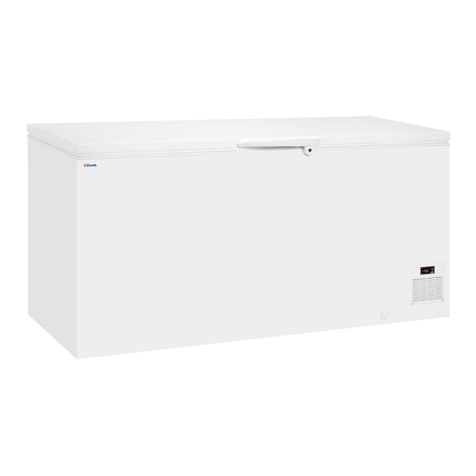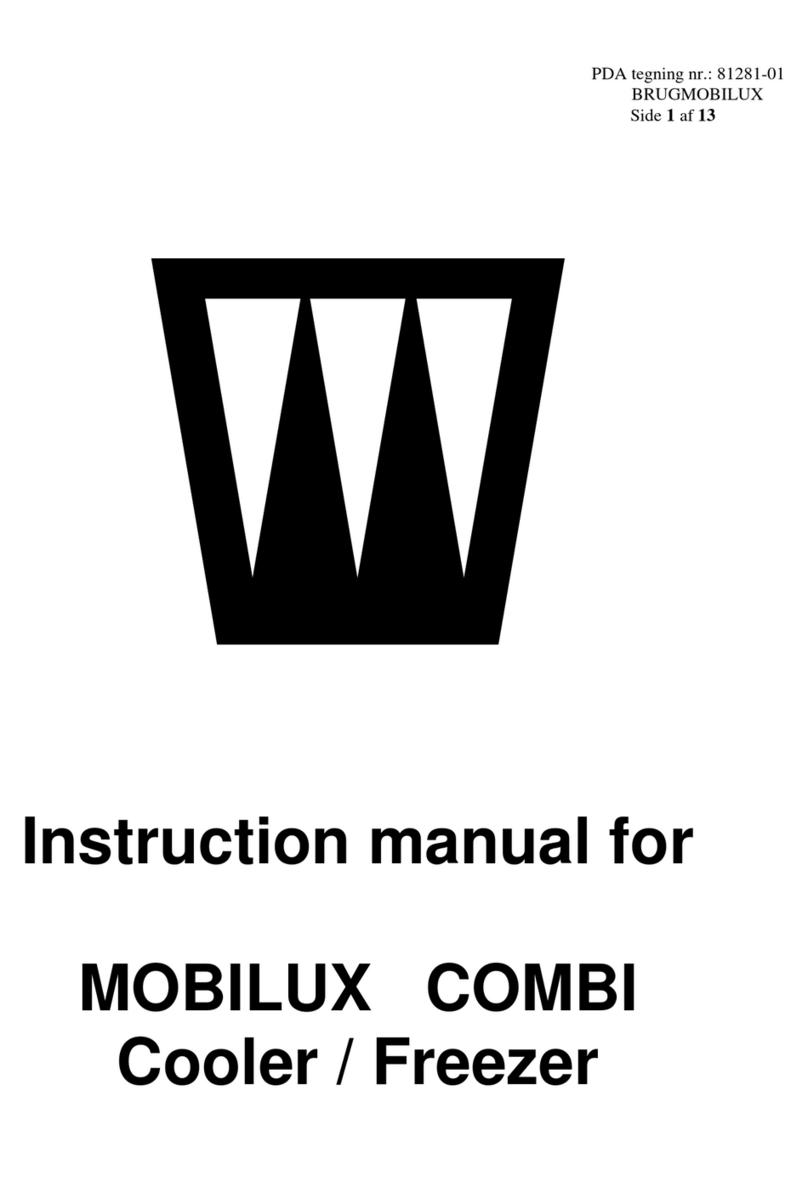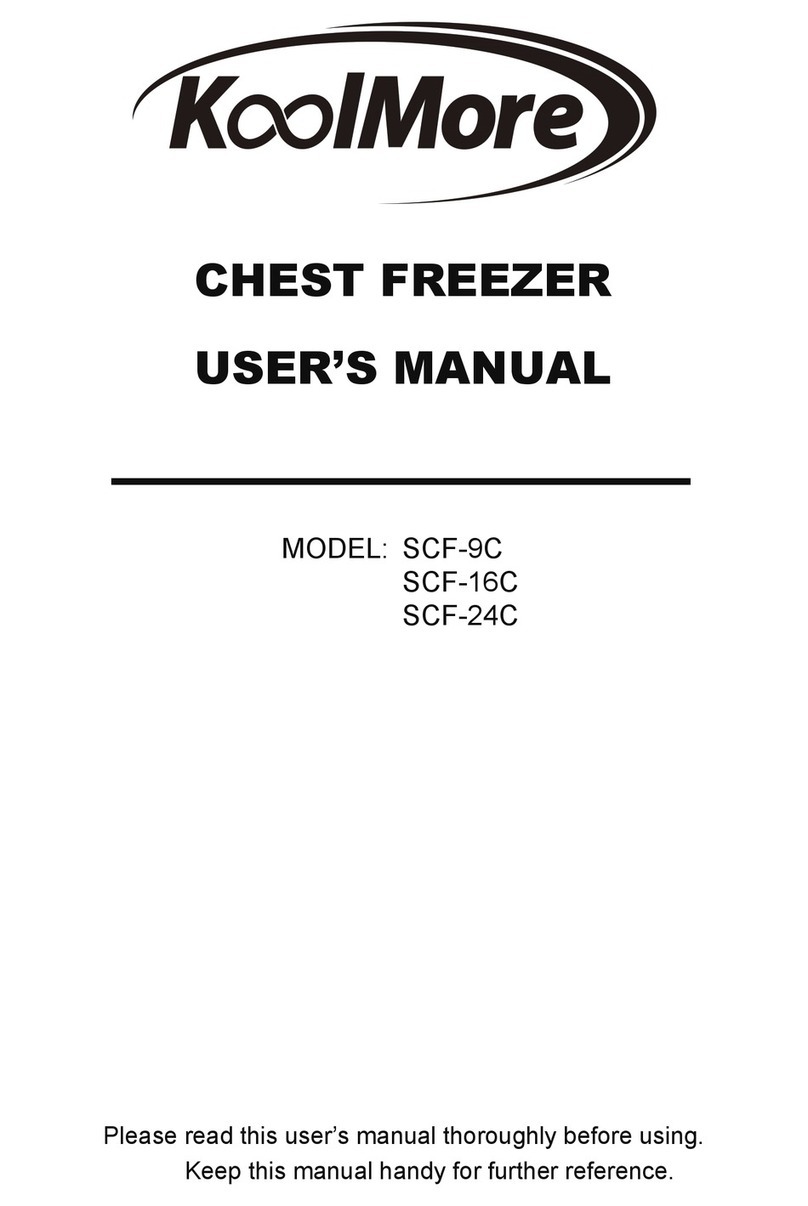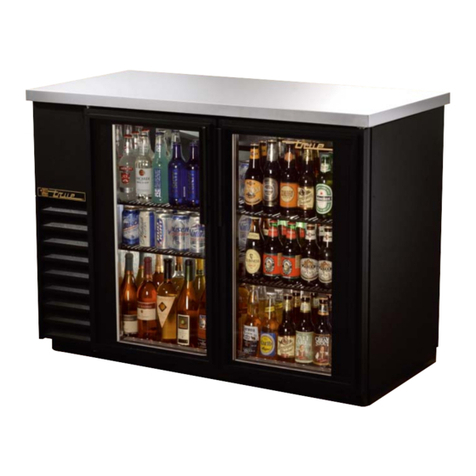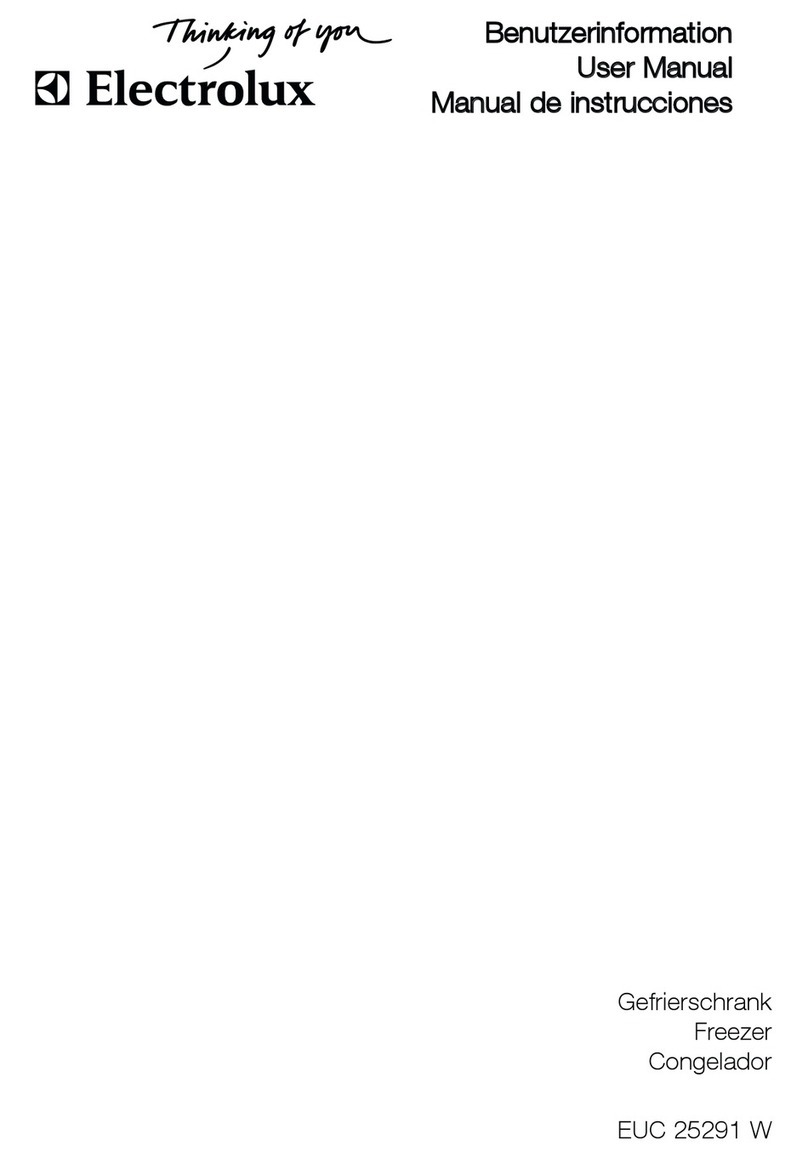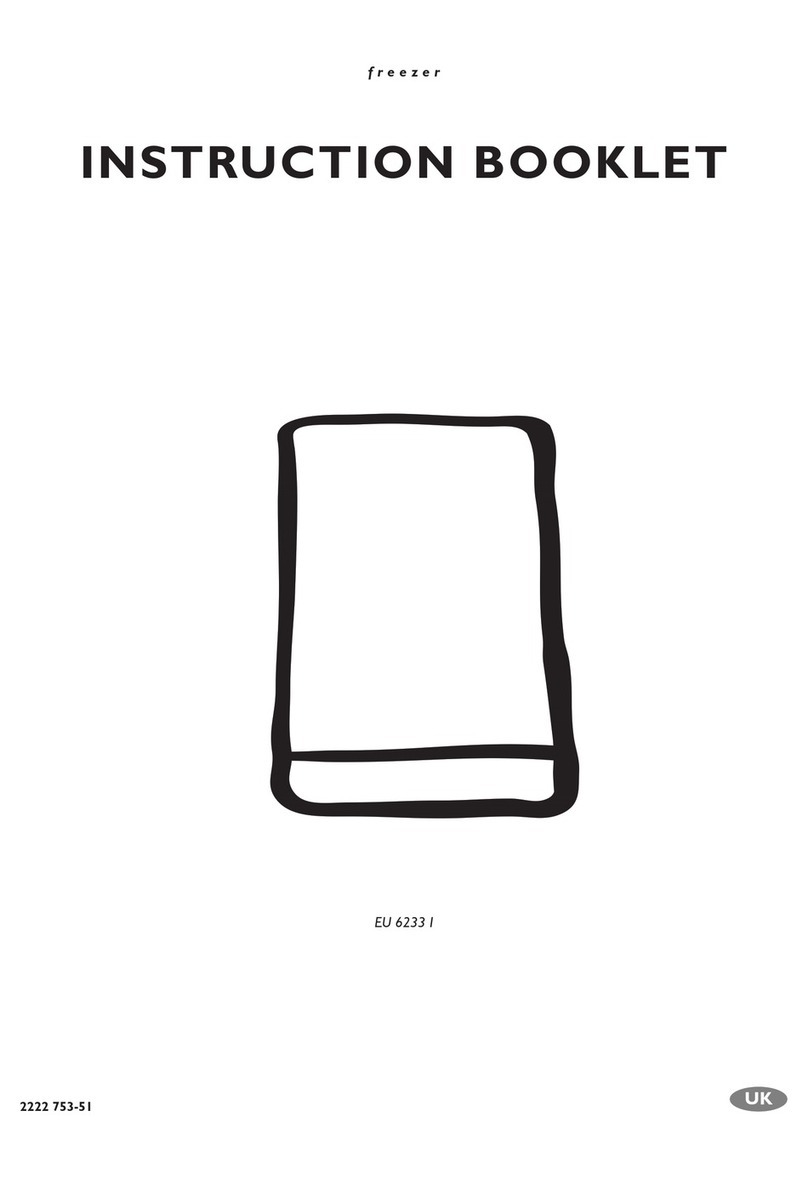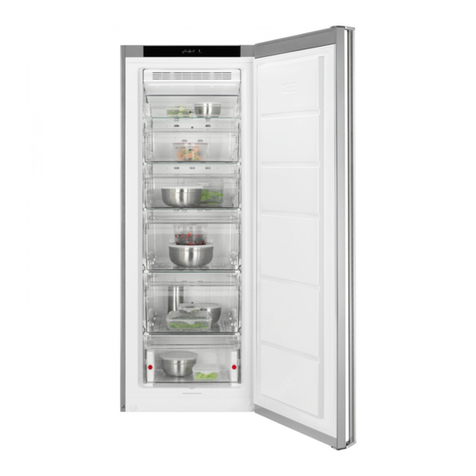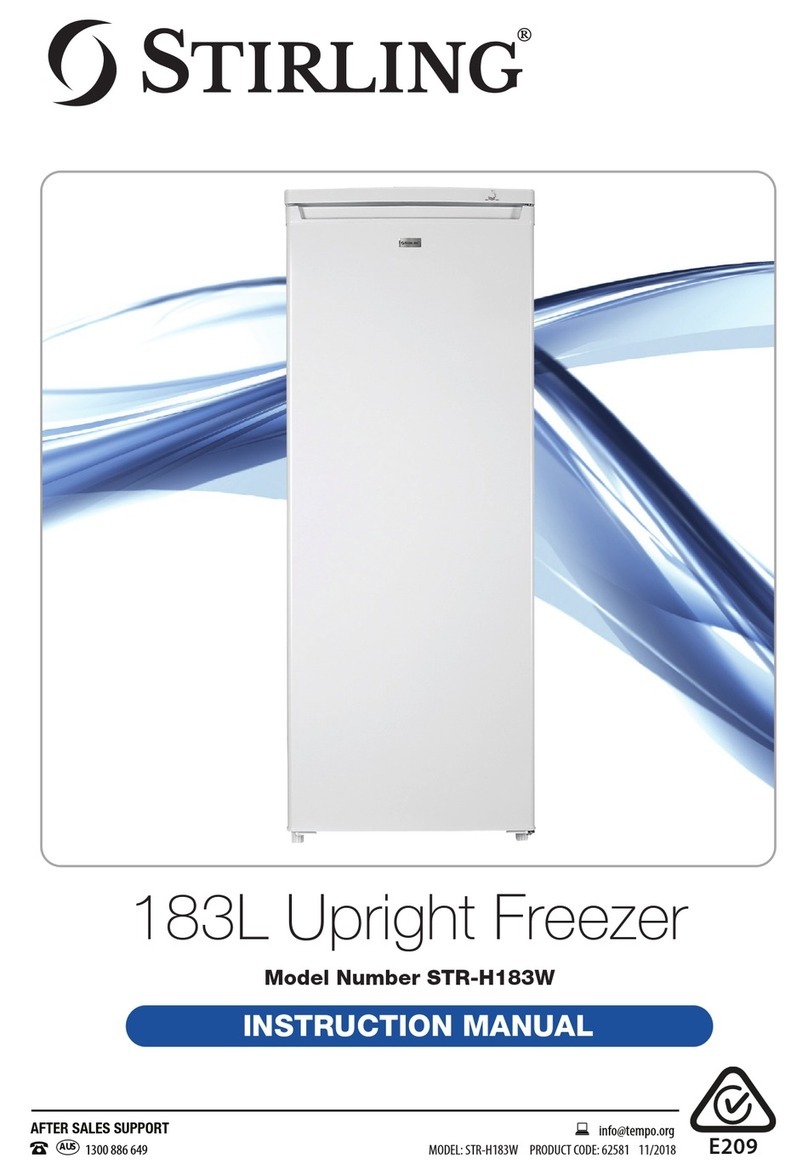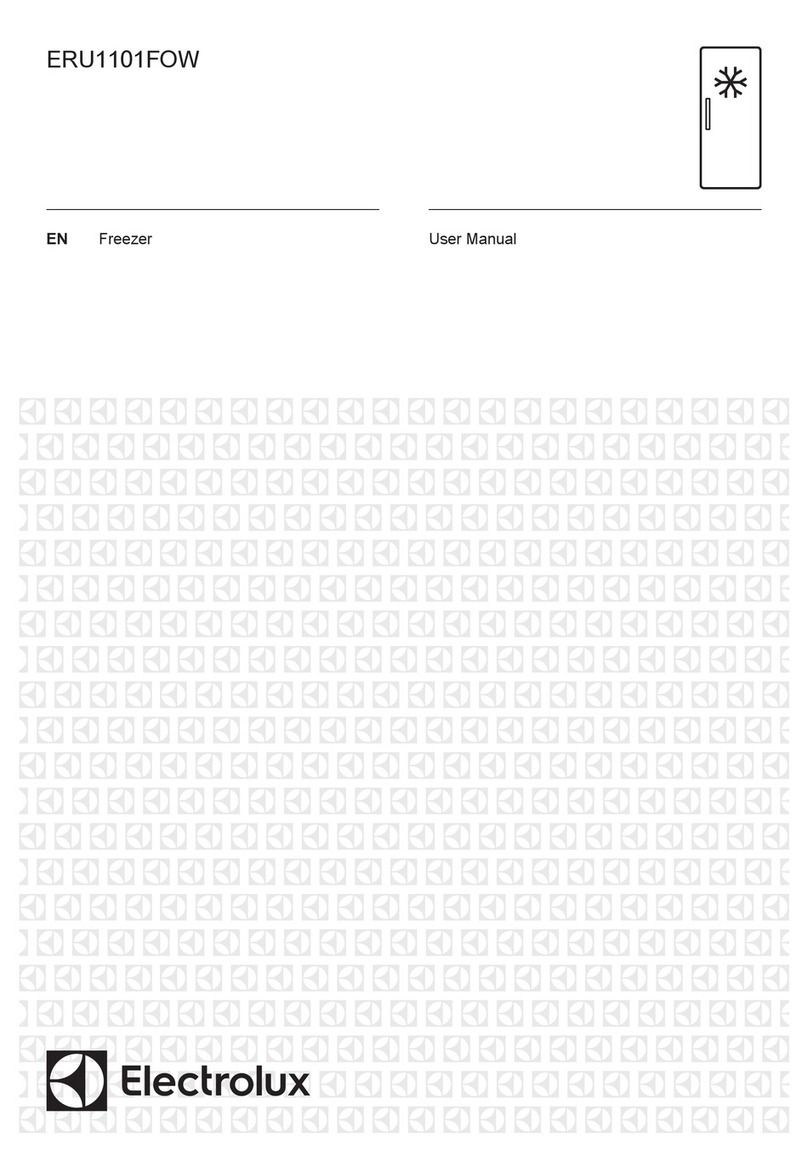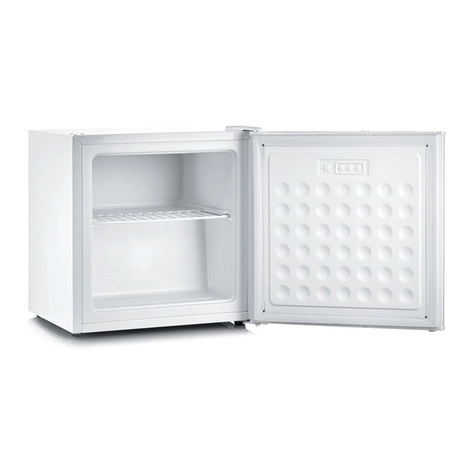Elcold LAB Series User manual


Ultra Low Temperature Freezers Model LAB
User Instructions
Lab* Frost

User Instructions Ultra Low Temperature Freezers Model LAB
Side 1 | 14
SAFETY INFORMATIONS
The LAB freezers contains environmentally friendly but flammable refrigerants. It means
danger of explosion if for any reason the refrigerants are allowed to escape from the
system.
The refrigeration system must never be accessed by unauthorized personal.
When transporting and installing the unit, ensure that no part of the tubing system is
damaged.
If the tubing is damaged and leak occurs, avoid any ignition sources and naked flames near
the unit, and ventilate the room immediately.
In order to avoid formation of flammable gas/air mixtures in case of a leak from the
refrigeration system, the room where the unit is placed must have a volume equivalent to
1m³ per 8 gr. of refrigerant in the cabinet.
WARNING!!!
The ventilation openings must never be covered or blocked.
Never use a stream or water cleaning device during cleaning or defrosting in order to avoid
short circuits in the electrical system.
Do not place any electrical devices in the freezer.
Products containing flammable gasses and explosives must not be stored in the freezer.
All units should be provided with installation and operating instructions. In addition to the
Clearances Installation, the instructions should contain such directions and information that
the manufacturer considers necessary for installation, maintenance, and use of the
refrigerator.
Installation and operating instructions should be provided with cautionary statements
concerning the handling, moving, and use of the refrigerator or freezer to avoid either
damaging the refrigerant tubing, or increasing the risk of a leak.
The shipping carton of a refrigerator or freezer that employs a flammable refrigerant
should be marked
"Caution - Risk of Fire or Explosion due to Flammable Refrigerant Used. Follow Handling
Instructions Carefully in Compliance with U.S. Government Regulations".
The warning marking should also appear on the shipping carton, see below.
The installation and operating instructions should indicate that component parts shall be
replaced with like components and that servicing shall be done by factory authorized
service personnel, so as to minimize the risk of possible ignition due to incorrect parts or
improper service.

User Instructions Ultra Low Temperature Freezers Model LAB
Side 2 | 14
USER INSTRUCTIONS
Congratulations with your new freezer, we
feel certain that it will be very useful to you
for many years ahead. To obtain optimal
benefit from your freezer, please read the
following instructions thoroughly and act
accordingly. The low-temperature freezers are
used for freezing and long-term storing of
food products, medical preparations
(vaccines, blood plasm, ect.) and other
biological products.
1. Environmental protection and
disposal
The packaging is designed to protect the
appliance and its components during
transportation, and it is made of recyclable
materials.
• Please return the packaging to an official
collection point for recycling.
• Old appliances contain reusable materials
and should not be disposed of together with
household refuse.
• Remove the spring-action hinges from the
appliance, in order to prevent children from
being entrapped in the appliance.
• Ensure that no part of the refrigeration
tubing is damaged as the refrigerant in the
appliance risks escaping to the environment.
• Information about refrigerant type and
amount will be found on the type plate on the
rear of the appliance (Fig. 1).
2. Safety instructions
• In order to prevent injuries and or damage to
the appliance, it should be unpacked and set
up by min. two people.
• If upon unpacking the appliance is found
damaged, do not connect to the mains, but
contact the supplier.
• Interference with or repair to the appliance
should only be carried out by authorized
personnel, in order to avoid any injuries.
(Contact the supplier for further
information).
• Never put naked flames or other ignition
sources inside the appliance.
• Never touch the freezers interior or products
in the freezer when the freezer is operating.
Use gloves or alike in order to avoid injuries
(frost-bite).
• Keep the key to the appliance away from the
appliance and out of the reach of children.
3. Connection to the mains
• For safety reasons, the appliance must be
earthed. If you are in any doubt, please
contact an authorized electrician.
• The appliance should be left for 5 hours
before it is connected to the mains. If the
appliance is connected before that, there is a
risk of damaging the compressor.
• If for any reason the appliance is
disconnected from the mains, please wait 10
minutes before re-connecting.
The electronic starting device needs this time
to cool down, before a safe re-start can be
made.
4. Before use
• Before use, the interior of the appliance
should be cleaned with a mild soap solution,
and wiped off with a dry clean cloth. Never
use any kind of solvent or other chemicals
5. Setting up the freezer
The freezer should not be placed where it
might be splashed with water, in extreme high
humidity or in direct sunlight. Any of these
factors may lead to a reduction in
performance and shorten the life span of the
components. The freezer should be placed on
a horizontal level, and should not be placed
close to a heating appliance or heating tubes.
Allow a minimum of 50mm (2”) clearance on
the side and the back.
The side with the ventilation grill should have
a clearance of at least 100 mm (4”) in order to

User Instructions Ultra Low Temperature Freezers Model LAB
Side 3 | 14
allow the heat from the compressor motor to
dissipate. Underneath the appliance these
should be a gap of 15 mm approx. (1/2”). On
a soft surface, e.g. carpet, it may be necessary
to ensure the correct distance by means of
spacers.
6. Electrical supply
The electrical supply should always be in
accordance with the rating plate on the back
of the freezer.
The supply must always be in accordance
with the law and regulations regarding
electrical safety.
If any doubts, contact your supplier.
Fig. 1
7. Starting Up
In case the compressor does not start when
the freezer has been plugged in, the electrical
supply may not be in order. Check if there is
an electricity supply to the plug or if the fuse
is blown. If not please go to trouble shooting
page 5.
8. Operating the freezer
The empty freezer should be switched on for
at least 5-6 hours prior to loading of the
freezer.
The freezer should not be loaded above the
inside walls which is also the load line limit.
Please note: After the lid has been opened,
there will be a vacuum created inside the
freezer due to the low temperatures. Wait a
few minutes before trying to re-open the lid
otherwise the handle could be damaged.
9. Defrosting
In order for the freezer to work to its
maximum efficiency the cabinet should be
defrosted when a approx. 2mm thick ice layer
has formed inside the cabinet.
The ice layer is easily removed with a plastic
or wooden scraper.
Never use a sharp metal object which
might will cause damage to the inner liner.
The defrosting frequency is determined
mainly by two factors the usage pattern
(number of lid openings) and the relative
humidity.
Excess water can be drained out by using the
drain water outlet on the front of the freezer.
10. Cleaning
Cleaning should be done when needed.
When used in a dirty environment it might be
necessary to remove the compressor

User Instructions Ultra Low Temperature Freezers Model LAB
Side 4 | 14
compartment grill, and clean the compressor
compartment eventually with a vacuum
cleaner.
If the cleaning process is neglected there is a
risk that the performance of the freezer will
be effected, and even damage to the
compressor could occur due to overheating.
11. Storage
If the freezer is stored for a period of the time,
the lid should be kept open for free circulation
of air inside the cabinet in order to avoid
corrosion of the inner liner.
12. Temperature control
LAB freezers
The temperature inside the freezer is
controlled by the electronic controller placed
in the front grill.
The controller has a digital readout of the
temperature inside the cabinet, and the option
of changing the temperature inside the
cabinet.
13. External voltage and
temperature alarm
Optionally the freezer can be equipped with a
battery operated alarm box with connections
for external alarm for voltage failure and
temperature alarm. The battery should be
exchanged every two years.
Please note! When commissioning the
freezer, the battery must be turned into its
correct position.
14. Dixell controller
15. Functions
How to see the set point:
1. Press and immediately release the SET key,
the display will now show the set point value.
2. Press and immediately release the SET key
or wait for 5 seconds to display the probe
value again.
How to lock and unlock the keyboard:
1. Press the up and down keys simultaneously
for more than 3 seconds.
How to change the set point:
1. Press the SET key for more than 3 seconds
to change the set point value.
2. The set point value will be displayed and
the LED starts flashing.
3. To change the set point value, push the up
or down arrow.
4. To memorise the new setting press the SET
key again or wait 15 seconds for the
controller to return to normal display of the
probe temperature.
16. Setting the controllers
offset value
The freezer is designed for long time and safe
storage of sensitive food products.
In some situations, the LAB freezer is also
used for other applications like in laboratories
for different low temperature test.
Depending on the actual situation it might be
necessary to change the controllers offset

User Instructions Ultra Low Temperature Freezers Model LAB
Side 5 | 14
value in order to get a correspondence
between the reading on the display and the
actual temperature inside the cabinet.
The offset can be adjusted in the following
way:
Unlock the keyboard.
Enter the programming mode by pressing the
SET and arrow down keys for 3 seconds.
Select the parameter “Ot” by pressing arrow
up or down key.
Press the SET key to display its value.
Use arrow up or down to change its value.
The offset can be adjusted to +/- 12 dgr.C
Press SET to store the new value.
Press SET + arrow up or wait 15 seconds
without pressing any key. The new value will
now be stored.
For more detailed information about
programming the Dixell controllers please
consult the attached manuals.
17. Trouble shooting
The appliance is not operating. Please check
the following before calling for service:
Is the electrical plug connected to the mains
(wall socket)? Is the fuse blown?
The appliance is operating continuously.
Please check:
Is ambient temperature too high?
Has the appliance recently been loaded with a
large of warm products?
The temperature inside the appliance is too
high. Please check:
Is the Dixell controller set to the correct
temperature?
Has an excess amount of ice formed inside the
appliance?
If you have checked the above points and the
appliance is still not working as expected,
please contact your local dealer for further
advice.
18. LN2or LCO2back-up
On the rear side of the cabinet there is a label
and a marking, where it is possible to insert
either a temperature probe or a back-up LN2
or LCO2 supply.
The inner and outer skins are pre-drilled.
IMPORTANT NOTE !!!
Do not attempt to drill or in other way
make access to the freezers interior other
places than at the marking, there is a risk
of damaging the freezers tubing system,
resulting in a leakage with inflammable
gasses.
Back
-
up inlet

Side 6 | 14
4.1 USE OF LEDS
4. FRONT PANEL COMMANDS
CONTENTS
1. GENERAL WARNING 6
2. GENERAL DESCRIPTION 6
3. CONTROLLING LOADS 6
4. FRONT PANEL COMMANDS 6
5. MAX & MIN TEMPERATURE MEMORIZATION 6
6. MAIN FUNCTIONS 6
7. PARAMETERS 7
8. DIGITAL INPUT (ENABLED WITH P3P = N) 8
9. TTL SERIAL LINE – FOR MONITORING SYSTEMS 8
10. X-REP OUTPUT – OPTIONAL 8
11. INSTALLATION AND MOUNTING 8
12. ELECTRICAL CONNECTIONS 8
13. HOW TO USE THE HOT KEY 9
14. ALARM SIGNALS 9
15. TECHNICAL DATA 9
16. CONNECTIONS 9
17. FACTORY SETTINGS DIXELL XR30CH 10
1. GENERAL WARNING
·This manual is part of the product and should be kept near the instrument for easy and
quick reference.
·The instrument shall not be used for purposes different from those described hereunder.
It cannot be used as a safety device.
·Check the application limits before proceeding.
·Dixell Srl reserves the right to change the composition of its products, even without
notice, ensuring the same and unchanged functionality.
: To display target set point; in programming mode it selects a parameter or confirm
an operation.
(DEF) To start a manual defrost
(UP): To see the max. stored temperature; in programming mode it browses the
parameter codes or increases the displayed value.
(DOWN): To see the min stored temperature; in programming mode it browses the
parameter codes or decreases the displayed value.
To switch the instrument off, if onF = oFF.
To switch the light, if oA1 =Lig
KEY COMBINATIONS:
+
To lock & unlock the keyboard.
+
To enter in programming mode.
+
To return to the room temperature display.
·Check the supply voltage is correct before connecting the instrument.
·Do not expose to water or moisture: use the controller only within the operating limits
avoiding sudden temperature changes with high atmospheric humidity to prevent
formation of condensation
·Warning: disconnect all electrical connections before any kind ofmaintenance.
·Fit the probe where it is not accessible by the End User. The instrument must not be
opened.
·In case of failure or faulty operation send the instrument back to the distributor or to
“Dixell S.r.l.” (see address) with a detailed description of thefault.
·Consider the maximum current which can be applied to each relay (see Technical Data).
·Ensure that the wires for probes, loads and the power supply are separated and far
enough from each other, without crossing orintertwining.
·In case of applications in industrial environments, the use of mains filters (our mod. FT1)
in parallel with inductive loads could be useful.
2. GENERAL DESCRIPTION
Model XR30CH, format 32 x 74 mm, is a digital thermostat with off cycle defrost designed for
refrigeration applications at normal temperature. It provides two relay outputs, one for the
compressor, the other one can be used as light, for alarm signalling or as auxiliary output..
It is also provided with 2 NTC or PTC probe inputs, the first one for temperature control,
the second one, optional, to connect to the HOT KEY terminals to signal the condenser
temperature alarm or to display a temperature. The digital input can operate as third
temperature probe.
The HOT KEY output allows to connect the unit, by means of the external module XJ485-CX,
to a network line ModBUS-RTU compatible such as the dIXEL monitoring units of X-WEB
family. It allows to program the controller by means the HOT KEY programming keyboard.
The instrument is fully configurable through special parameters that can be easily
programmed through the keyboard.
3. CONTROLLING LOADS
5. MAX & MIN TEMPERATURE MEMORIZATION.
1.
Press and release the
key.
2. The “Lo” message will be displayed followed by the minimum temperature recorded.
3. By pressing the
key again or by waiting 5s the normal display will be restored.
1.
Press and release the
key.
2. The “Hi” message will be displayed followed by the maximum temperature recorded.
3.
By pressing the
key again or by waiting 5s the normal display will be restored.
1. Hold press the SET key for more than 3s, while the max. or min temperature is
displayed. ( rSt message will be displayed )
2. To confirm the operation the “rSt” message starts blinking and the normal temperature
will be displayed.
6. MAIN FUNCTIONS
LED
MODE
FUNCTION
ON Compressor enabled
Flashing Anti-short cycle delay enabled
ON Defrost enabled
ON An alarm is occurring
ON Continuous cycle is running
ECO
ON Energy saving enabled
ON Light on
ON Auxiliary relay on
°C/°F
ON Measurement unit
°C/°F
Flashing Programming phase
6.1HOW TO SEE THE SETPOINT
1.2 SAFETY PRECAUTIONS
5.3 HOW TO RESET THE MAX AND MIN TEMPERATURE RECORDED
5.2 HOW TO SEE THE MAX TEMPERATURE
5.1 HOW TO SEE THE MIN TEMPERATURE
1.1 PLEASE READ BEFORE USING THIS MANUAL
Digital controller with off cycle defrost and AUXrelay
XR30CH
3.1 COMPRESSOR
The regulation is performed
according to the temperature
measured by the thermostat probe
with a positive differential from the
set point: if the temperature
increases and reaches set point
plus differential the compressor is
started and then turned off when
the temperature reaches the set
point value again.
Temper.
SET
Time
Compr.
ON
In case of fault in the thermostat probe the start and stop of the compressor are timed
through
parameters “COn” and “COF”.Defrost
Defrost is performed through a simple stop of the compressor. Parameter “IdF” controls
the
interval between defrost cycles, while its length is controlled by parameter “MdF”.
1. Push and immediately release the SET key: the display
will show the Set point value.
2. Push and immediately release the SET key or wait for 5
seconds to display the probe value again.
Each LED function is described in
the following
table.

User Instructions Ultra Low Temperature Freezers Model LAB
Side 7 | 14
To change the parameter’s value operate as follows:
1. Enter the Programming mode by pressing the Set +
keys for 3s (the “°C” or
“°F” LEDstarts blinking).
2. Select the required parameter. Press the “SET” key to display its value
3. Use “UP” or “DOWN” to change its value.
4. Press “SET” to store the new value and move to the following parameter.
To exit: Press SET + UP or wait 15s without pressing a key.
NOTE: the set value is stored even when the procedure is exited by waiting the
time-out to expire.
The hidden menu Includes all the parameters of the instrument.
6.5.1 HOW TO ENTER THE HIDDEN MENU
1. Enter the Programming mode by pressing the Set +
keys for 3s (the “°C” or
“°F” LED starts blinking).
2. Released the keys, then push again the Set + keys for more than 7s.
The Pr2 label willbe displayed immediately followed from the HY parameter.
NOW YOU ARE IN THE HIDDENMENU
3. Select the required parameter.
4. Press the “SET” key to display its value
5.
Use
or
to change its value.
6. Press “SET” to store the new value and move to the following parameter.
To exit: Press SET +
or wait 15s without pressing a key.
NOTE1: if none parameter is present in Pr1, after 3s the “noP” message is
displayed. Keep the keys pushed till the Pr2 message is displayed.
NOTE2: the set value is stored even when the procedure is exited by waiting the
time-out to expire.
6.5.2 HOW TO MOVE A PARAMETER FROM THE HIDDEN
MENU TO THE FIRST LEVEL AND VICEVERSA.
Each parameter present in the HIDDEN MENU can be removed or put into “THE
FIRST LEVEL” (user level) by pressing “SET + ”.
In HIDDEN MENU when a parameter is present in First Level the decimal point is on.
1. Keep pressed for more than 3 s the UP + DOWN keys.
2. The “POF” message will be displayed and the keyboard will be locked. At this
point it will be possible only to see the set point or the MAX o Min temperature
stored
3. If a key is pressed more than 3s the “POF” message will be displayed.
Keep pressed together for more than 3s the
and
keys, till the “Pon”
message will be
displayed.
When defrost is not in progress, it can be activated by holding the “o” key pressed for
about3 seconds. The compressor operates to maintain the “ccS” set point for the time
set through the “CCt” parameter. The cycle can be terminated before the end of the
set time using the same activation key “o” for 3 seconds.
With “onF = oFF”, pushing the ON/OFF key, the instrument is switched off.
The “OFF” message is displayed. In this configuration, the regulation is disabled.
To switch the instrument on, push again the ON/OFF key.
WARNING: Loads connected to the normally closed contacts of the relays are
always supplied and under voltage, even if the instrument is in stand by mode.
7. PARAMETERS .
Hy Differential: (0,1 ÷ 25,5°C / 1÷255 °F) Intervention differential for set point.
Compressor Cut IN is Set Point + differential (Hy). Compressor Cut OUT is when
the temperature reaches the set point.
LS Minimum set point: (- 50°C÷SET/-58°F÷SET): Sets the minimum value for the
set point.
US Maximum set point: (SET÷110°C/ SET÷230°F). Set the maximum value for set
point.
Ot Thermostat probe calibration: (-12.0÷12.0°C; -120÷120°F) allows to adjust
possible offset of the thermostat probe.
P3P Third probe presence (P3): n= not present:, the terminal operates as digital
input.; y=present:, the terminal operates as third probe.
O3 Third probe calibration (P3): (-12.0÷12.0°C; -120÷120°F). allows to adjust
possible offset of the third probe.
P4P Fourth probe presence: (n = Not present; y = present).
o4 Fourth probe calibration: (-12.0¸12.0°C) allows to adjust possible offset of the
fourth probe.
OdS Outputs activation delay at start up: (0÷255min) This function is enabled at the
initial start up of the instrument and inhibits any output activation for the period
of time set in the parameter.
AC Anti-short cycle delay: (0÷50 min) minimum interval between the compressor
stop and the following restart.
CCt Compressor ON time during continuous cycle: (0.0÷24.0h; res. 10min) Allows
to set the length of the continuous cycle: compressor stays on without interruption
for the CCt time. Can be used, for instance, when the room is filled with newproducts.
CCS Set point for continuous cycle: (-50÷150°C) it sets the set point used
during the continuous cycle.
COn Compressor ON time with faulty probe: (0÷255 min) time during which the
compressor is active in case of faulty thermostat probe. With COn=0 compressor
is always OFF.
COF Compressor OFF time with faulty probe: (0÷255 min) time during which the
compressor is OFF in case of faulty thermostat probe. With COF=0 compressor is
always active.
CH Type of action: CL = cooling; Ht = heating.
DISPLAY
CF Temperature measurement unit: °C=Celsius; °F=Fahrenheit. WARNING:
When the measurement unit is changed the SET point and the values of the
parameters Hy, LS, US, Ot, ALU and ALL have to be checked and modified if
necessary).
rES Resolution (for °C): (in = 1°C; dE = 0.1 °C) allows decimal pointdisplay.
dLy Display delay: (0 ÷20.0m; risul. 10s) when the temperature increases, the
display is updated of 1 °C/1°F after this time.
IdF Interval between defrost cycles: (0÷120h) Determines the time interval
between the beginning of two defrost cycles.
MdF (Maximum) length for defrost: (0÷255min) When P2P = n, (not evaporator
probe: timed defrost) it sets the defrost duration, when P2P = y (defrost end
based on temperature) it sets the maximum length for defrost.
dFd Temperature displayed during defrost: (rt = real temperature; it =
temperature at defrost start; SEt = set point; dEF = “dEF” label)
dAd MAX display delay after defrost: (0÷255min). Sets the maximum time
between the end of defrost and the restarting of the real room temperature
display.
ALARMS
ALC Temperature alarms configuration: (Ab; rE)
Ab= absolute temperature: alarm temperature is given by the ALL or ALU
values. rE = temperature alarms are referred to the set point. Temperature
alarm is enabled when the temperature exceeds the “SET+ALU” or “SET-ALL”
values.
ALU MAXIMUM temperature alarm: (SET÷110°C; SET÷230°F) when this
temperature is reached the alarm is enabled, after the “ALd” delay time.
ALL Minimum temperature alarm: (-50.0 ÷ SET°C; -58÷230°F when this
temperature is reached the alarm is enabled, after the “ALd” delay time.
AFH Differential for temperature alarm recovery: (0,1÷25,5°C; 1÷45°F)
Intervention differential for recovery of temperature alarm.
ALd Temperature alarm delay: (0÷255 min) time interval between the detection of
an alarm condition and alarm signalling.
dAO Exclusion of temperature alarm at startup: (from 0.0 min to 23.5h) time
interval between the detection of the temperature alarm condition after
instrument power on and alarm signalling.
6.2 HOW TO CHANGE THE SETPOINT
6.3 HOW TO START A MANUAL DEFROST
6.4 HOW TO CHANGE A PARAMETER VALUE
DEFROST
REGULATION
6.9 THE ON/OFF FUNCTION
6.8 THE CONTINUOUS CYCLE
6.7 TO UNLOCK THE KEYBOARD
6.6 HOW TO LOCK THE KEYBOARD
6.5 THE HIDDEN MENU
1. Push the SET key for more than 2 seconds to change the Set point value.
2. The value of the set point will be displayed and the “°C” or “°F” LED starts blinking;
3.
To change the Set value push the
or
arrows within 10s.
4. To memorise the new set point value push the SET key again or wait 10s.
Push the
DEF
key
for more than 2 seconds and
a manual defrost
will start.

User Instructions Ultra Low Temperature Freezers Model LAB
Side 8 | 14
CONDENSER TEMPERATURE ALARM (detected by the fourth probe)
AP2 Probe selection for temperature alarm of condenser: nP = no probe;
P1 =thermostat probe; P2 = evaporator probe; P3 =configurable probe; P4 =
Probe on Hot Key plug.
AL2 Low temperature alarm of condenser: (-55÷150°C) when this temperature is
reached the LA2 alarm is signalled, possibly after the Ad2 delay.
Au2 High temperature alarm of condenser: (-55÷150°C) when this temperature is
reached the HA2 alarm is signalled, possibly after the Ad2delay.
AH2 Differential for temperature condenser alarm recovery: (0,1÷25,5°C; 1÷45°F)
Ad2 Condenser temperature alarm delay: (0÷255 min) time interval between the
detection of the condenser alarm condition and alarm signalling.
dA2 Condenser temperature alarm exclusion at start up: (from 0.0 min to
23.5h, res.10min)
bLL Compressor off with low temperature alarm of condenser: n = no:
compressor keeps on working; Y = yes, compressor is switched off till the
alarm is present, in any case regulation restarts after AC time at minimum.
AC2 Compressor off with high temperature alarm of condenser: n = no:
compressor keeps on working; Y = yes, compressor is switched off till the
alarm is present, in any case regulation restarts after AC time at minimum.
SECOND RELAY
tbA Alarm relay silencing (with oA1=ALr):
(n= silencing disabled: alarm relay stays on till alarm condition lasts,
y =silencing enabled: alarm relay is switched OFF by pressing a key during
an alarm).
oA1 Second relay configuration: ALr: alarm; Lig: light; AuS: Auxiliary relay;
onF: always on with instrument on; db = do not select it; dEF:
do not select it!.; FAn: do not select it!.; dF2: do not select it.
AoP Alarm relay polarity: it set if the alarm relay is open or closed when an alarm
happens. CL= terminals 1-2 closed during an alarm;
oP = terminals 1-2 open during an alarm
i1P Digital input polarity: oP: the digital input is activated by opening the
contact; CL: the digital input is activated by closing the contact.
i1F Digital input configuration: EAL = external alarm: “EA” message is displayed;
bAL = serious alarm “CA” message is displayed. PAL
pressure switch alarm, “CA” message is displayed; dor = door
switch function; dEF = activation of a defrost cycle; AUS =to
switch on the second relay if oA1 = Htr = kind of action
inversion (cooling – heating); FAn = not set it;
did: (0¸255 min) with i1F= EAL or i1F = bAL digital input alarm delay: delay
between the detection of the external alarm condition and itssignalling.
with i1F= dor: door open signalling delay
with i1F = PAL: time for pressure switch function: time interval to calculate
the number of the pressure switch activation.
nPS Pressure switch number: (0 ÷15) Number of activation of the pressure switch,
during the “did” interval before signaling the alarm event.(12F = PAL)
If the nPS activation in the did time is reached, switch off and on the instrument
to restart normal regulation.
odc Compressor status with door open: no, Fan = normal; CPr;
F_C = Compressor OFF.
rrd Outputs restart after doA alarm: no = outputs not affected by the doA alarm;
yES = outputs restart with the doA alarm;
HES Temperature increase during the Energy Saving cycle it sets the increasing
value of the set point during the Energy Saving cycle
Adr Serial address (1÷244): Identifies the instrument address when connected to a
ModBUS compatible monitoring system.
PbC Type of probe: it allows to set the kind of probe used by the instrument: PbC = PBC
probe, ntc = NTC probe.
onF on/off key enabling: nu = disabled; oFF = enabled; ES = not set it.
dP1 Thermostat probe display
dP3 Third probe display- optional.
dP4 Fourth probe display.
rSE Real set point: (readable only), it shows the set point used during the energy saving
cycle or during the continuous cycle.
rEL Software release for internal use.
Ptb Parameter table code: readable only.
8. DIGITAL INPUT (ENABLED WITH P3P = N)
The free voltage digital input is programmable in different configurations by the “i1F”
parameter.
It signals the door status and the corresponding relay output status through
the “odc” parameter: no, Fan = normal (any change); CPr, F_C = Compressor OFF.
Since the door is opened, after the delay time set through parameter “did”, the door
alarm is enabled, the display shows the message “dA” and the regulation restarts
is rtr = yES. The alarm stops as soon as the external digital input is disabled again.
With the door open, the high and low temperature alarms are disabled.
As soon as the digital input is activated the unit will wait for “did” time delay before
signaling the “EAL” alarm message. The outputs status don´t change. The alarm
stops just after the digital input is de-activated.
When the digital input is activated, the unit will wait for “did” time delay before
signaling the “CA” alarm message. The relay outputs are switched OFF. The alarm
will stop as soon as the digital input is de-activated.
If during the interval time set by “did” parameter, the pressure switch has reached
the number of activation of the “nPS”parameter, the “CA”pressure alarm
message will be displayed. The compressor and the regulation are stopped. When
the digital input is ON the compressor is always OFF.
If the nPS activation in the did time is reached, switch off and on the
instrument to restart normal regulation.
It starts a defrost if there are the right conditions. After the defrost is finished, the
normal regulation will restart only if the digital input is disabled otherwise the
instrument will wait until the “MdF” safety time is expired.
This function allows to invert the regulation of the controller: from cooling to
heating and viceversa.
The Energy Saving function allows to change the set point value as the result of
the SET+HES (parameter) sum. This function is enabled until the digital input is
activated.
The digital input polarity depends on the “i1P” parameter.
i1P=CL:the input is activated by closing the contact.
i1P=OP:the input is activated by opening the contact
The TTL serial line, available through the HOT KEY connector, allows by means of
the external TTL/RS485 converter, XJ485-CX, to connect the instrument to a
monitoring system ModBUS-RTU compatible such as the X-WEB500/3000/300.
As optional, an X-REP can be connected to the instrument, trough the HOT KEY
connector. The X-REP output EXCLUDES the serial connection.
To connect the X-REP to
the instrument the following
connectors must be used
CAB-51F(1m) CAB-
52F(2m), CAB- 55F(5m)
Instrument XR30CH shall be mounted on
vertical panel, in a 29x71 mm hole, and fixed
using the special bracket supplied. The
temperature range allowed for correct
operation is 0÷60 ˚C. Avoid places subject to
strong vibrations, corrosive gases, excessive
dirt or humidity. The same recommendations
apply to probes. Let air circulate by the
cooling holes.
The instrument is provided with screw terminal block to connect cables with a
cross section up to 2,5 mm². Before connecting cables make sure the
power supply complies with the instrument`s requirements. Separate the
probe cables from the power supply cables, from the outputs and the power
connections. Do not exceed the maximum current allowed on each relay, in
case of heavier loads use a suitable external relay.
12
.
ELECTRICAL CONNECTIONS
11. INSTALLATION
AND MOUNTING
9. TTL SERIAL LINE FOR MONITORING
SYSTEMS
DIGITAL INPUT
8.1 DOOR SWITCH INPUT (i1F = dor)
8.2 GENERIC ALARM (i1F = EAL)
8.3 SERIOUS ALARM MODE (i1F =bAL)
8.4 PRESSURE SWITCH (i1F = PAL)
8.5 START DEFROST (i1F =dFr)
8.6 INVERSION OF THE KIND OF ACTION: HEATING-COOLING (i1F = Htr)
8.7 ENERGY SAVING (i1F = ES)
8.8 DIGITAL INPUTS POLARITY
10. X
-
REP
OUTPUT
OPTIONAL
OTHER

User Instructions Ultra Low Temperature Freezers Model LAB
Side 9 | 14
The probes shall be mounted with the bulb upwards to prevent damages due to casual
liquid infiltration. It is recommended to place the thermostat probe away from air
streams to correctly measure the average room temperature. Place the defrost
termination probe among the evaporator fins in the coldest place, where most ice is
formed, far from heaters or from the warmest place during defrost, to prevent
premature defrost termination.
1. Program one controller with the front keypad.
2.
When the controller is ON , insert the
“
Hot key
”
and push key, the
“
uPL
”
message appears followed a by flashing
“
End
”
3. Push “SET” key and the End will stop flashing.
4. Turn OFF the instrument remove the “Hot Key”, then turn it ON again.
NOTE:the“Err”message is displayed for failed programming, in this case push
again key if you want to restart the upload again or remove the “Hot Key”
to abort the operation.
1. Turn OFF the instrument.
2.
Insert a programmed
“
Hot Key
”
into the 5 PIN receptacle and then
turn the Controller ON
3. Automatically the parameter list of the “Hot Key” is downloaded into the
Controller memory, the “doL” message is blinking followed a by flashingnd
“End”.
4. After 10 seconds the instrument will restart working with the new parameters.
5. Remove the “Hot Key”.
NOTE the message “Err” is displayed for failed programming, in this case turn
the unit off and then on if you want to restart the download again or remove the
“Hot key” to abort the operation.
14. ALARM SIGNALS S
Message
Cause Outputs
”P1”
Room probe failure Compressor output acc.
”P3”
Third probe failure Outputs unchanged
“P4”Fourth probe failure Outputs unchanged
”HA”
Maximum temperature alarm
Outputs unchanged
”LA”
Minimum temperature alarm Outputs unchanged
"HA2" Condenser high temperature
It depends on the “Ac2”
"LA2" Condenser low temperature
It depends on
”dA”
Door open Compressor according to rrd
”
EA”
External alarm Output unchanged
”CA”
Serious external alarm
(i1F=bAL)
All outputs OFF
”CA”
Pressure switch alarm
(i1F=PAL)
All outputs OFF
Probe alarms P1” ,” P3 “and “P4 “ start some seconds after the fault in the
related probe; they automatically stop some seconds after the probe restarts
normal operation. Check connections before replacing the probe.
Temperature alarms “HA”, “LA”, “HA2”, and “LA2” automatically
stop as soon as the temperature returns to normal values.
Alarms “EA” and “CA” (with I 1F = bAL) recover as soon as the
digital input is disabled.
Alarm “CA” (with i1F = PAL) recovers only by switching off and on
the instrument.
Housing: self-extinguishing ABS.
Case: XR30CH frontal 38 x 80 mm; depth 62 mm.
Mounting: XR30CH panel mounting in a 71 x 29 mm panel cut-out
Protection: IP20; Frontal protection: XR30CH IP65
Connections: Screw terminal block ≤ 2,5 mm²wiring.
Power supply: according to the model: 12Vac/dc, ± 10%; 24Vac/dc, ± 10%;
230 Vac ± 10%, 50/60 Hz, 110 Vac ± 10%, 50/60 Hz
Power absorption: 3VA max
Display:3 digits, red LED, 14,2 mm high; Inputs: Up to 4 NTC or PTC probes.
Digital input: free voltage contact
Relay outputs: compressor SPST 8(3) A, 250Vac; or 20(8) A 250Vac
AUX: SPDT 8(3) A, 250Vac
Data storing: on the non-volatile memory (EEPROM).
Kind of action: 1B; Pollution grade: 2; Software class: A.;
Rated impulsive voltage:2500V; Overvoltage Category: II
Operating temperature: 0÷60 °C; Storage temperature: -30÷85 °C.
Relative humidity: 20 85% (no condensing)
Measuring and regulation range: NTC probe: -40÷110°C (-40÷230°F);
PTC probe: -50÷150°C (-58÷302°F)
Resolution: 0,1 °C or 1°C or 1 °F (selectable);
Accuracy (ambient temp. 25°C):±0,7 °C ±1 digit.
The X-REP output excludes the TTL output. It´s present in the following codes:
XR30CH- xx2xx, XR30CH – xx3xx.
9-40Vdc supply: connect to the terminals 7 and 8.
12Vac/dc supply: connect to the terminals 7 and 8.
24Vac/dc supply: connect to the terminals 7 and 8.
120Vac supply: connect to the terminals 7 and 8.
14.2 OTHER MESSAGES
Pon Keyboard unlocked.
PoF Keyboard locked
noP In programming mode: none parameter is present in Pr1
On the display or in dP2, dP3, dP4: the selected probe is nor enabled
noA None alarm is recorded.
16.1 XR30CH 8A COMPRESSOR
8(3)A250V
20(8)A250V
Light/
N.C
.
Alarm
Comp
Hot
Key/IV
probe
TTL or X-REPoutput
Line
16
.
CONNECTIONS
15
. TECHNICAL DATA
13.2 HOW TO PROGRAM AN INSTRUMENT
USING A HOT KEY (DOWNLOAD)
13
.
HOW TO USE TH
E HOT KEY
13.1 HOW TO PROGRAM A HOT KEY FROM THE INSTRUMENT (UPLOAD)
12.1 PROBE CONNECTION
14.1 ALARM RECOVERY
9
-
40Vdc
supply
: connect to the terminals 7 and
8.
12Vac/dc supply: connect to the terminals 7 and 8.
24Vac/dc supply: connect to the terminals 7 and 8.
120Vac supply: connect to the terminals 7 and 8.
16.2 XR30CH –20A COMPRESSOR

User Instructions Ultra Low Temperature Freezers Model LAB
Side 10 | 14
17.
D
E
F
A
U
L
T
S
E
T
T
I
N
G
V
A
L
U
E
S
Lable Name Set
Set
Set point -80
Hy
Differential 3.0
LS Minimum set point -85
US
Maximum set point -50
Ot
Thermostat probe calibration 5.0
OdS Outputs delay at start up 0
AC
Anti-short cycle delay 5
CCt
Continuos cycle duration 0.0
CCS
Set point for continuous cycle, 0.0
COn
Compressor ON time with faulty probe 1
COF
Compressor OFF time with faulty probe 0
CH
Kind of action CL
CF
Temperature measurement unit °C
rES
Resolution dE
dLy
Display temperature del a y 0.0
IdF Interval between defrost cycles 0
MdF Maximum length for defrost 0
dFd Displaying during defrost rt
dAd MAX display delay after defrost 0
ALc Temperat. alarms configuration rE
ALU MAXIMUM temperature alarm 10.0
ALL MINIMUM temperature alarm 5.0
AFH Differential for temperat. alarm recovery 2.0
ALd Temperature alarm delay 60
dAo Delay of temperature alarm at start up 8.0
tbA Alarm relay disabling n
AoP Alarm relay polarity (oA1=ALr) OP
i1P Digital input polarity CL
i1F Digital input configuration AUS
did Digital input alarm delay 0
nPS Number of activation of pressure switch 0
odc Compress status when open door no
rrd Regulation restart with door open alarm
alarm
y
HES Differential for Energy Saving 0
Adr. Serial address 1
PbC Kind of probe pt1
onF on/off key enabling no
rSE Room probe display -85
rEL Software release 1.6
Ptb Map code 1
17. FACTORY SETTINGS DIXELL XR30CH

User Instructions Ultra Low Temperature Freezers Model LAB
Side 11 | 14

User Instructions Ultra Low Temperature Freezers Model LAB
Side 12 | 14

User Instructions Ultra Low Temperature Freezers Model LAB
Side 13 | 14

User Instructions Ultra Low Temperature Freezers Model LAB
Side 14 | 14
This manual suits for next models
2
Table of contents
Other Elcold Freezer manuals
Popular Freezer manuals by other brands
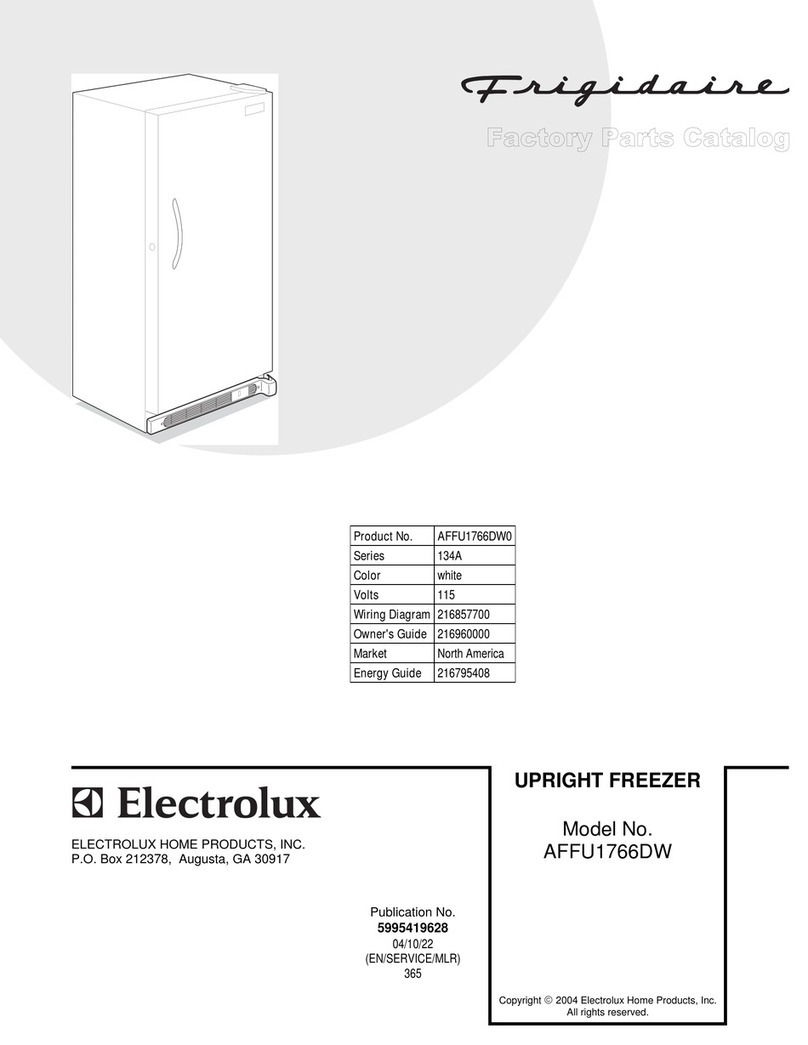
Frigidaire
Frigidaire AFFU1766DW Factory parts catalog
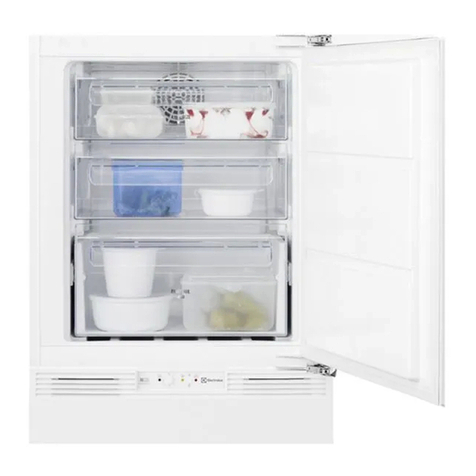
Electrolux
Electrolux ERU0943FOV user manual

Miele
Miele KFNS 37432 iD installation instructions
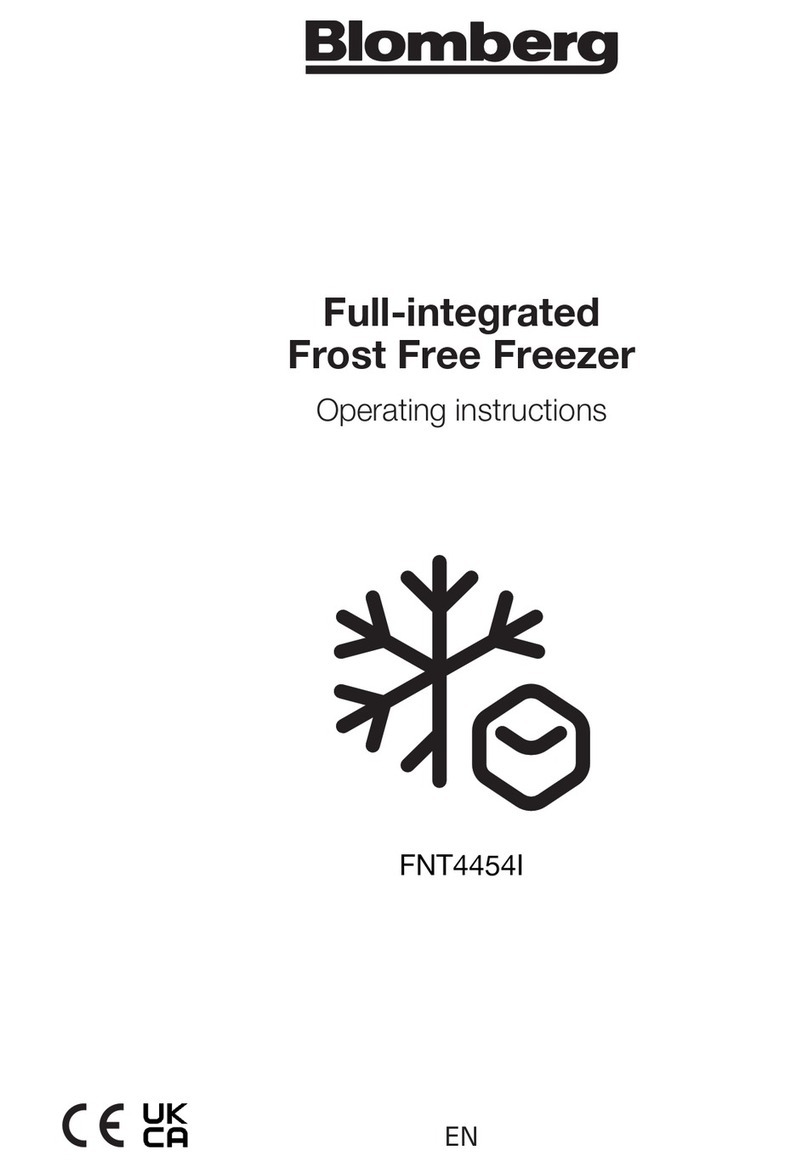
Blomberg
Blomberg FNT4454I operating instructions

Kuppersberg
Kuppersberg FBU 816 Technical Passport
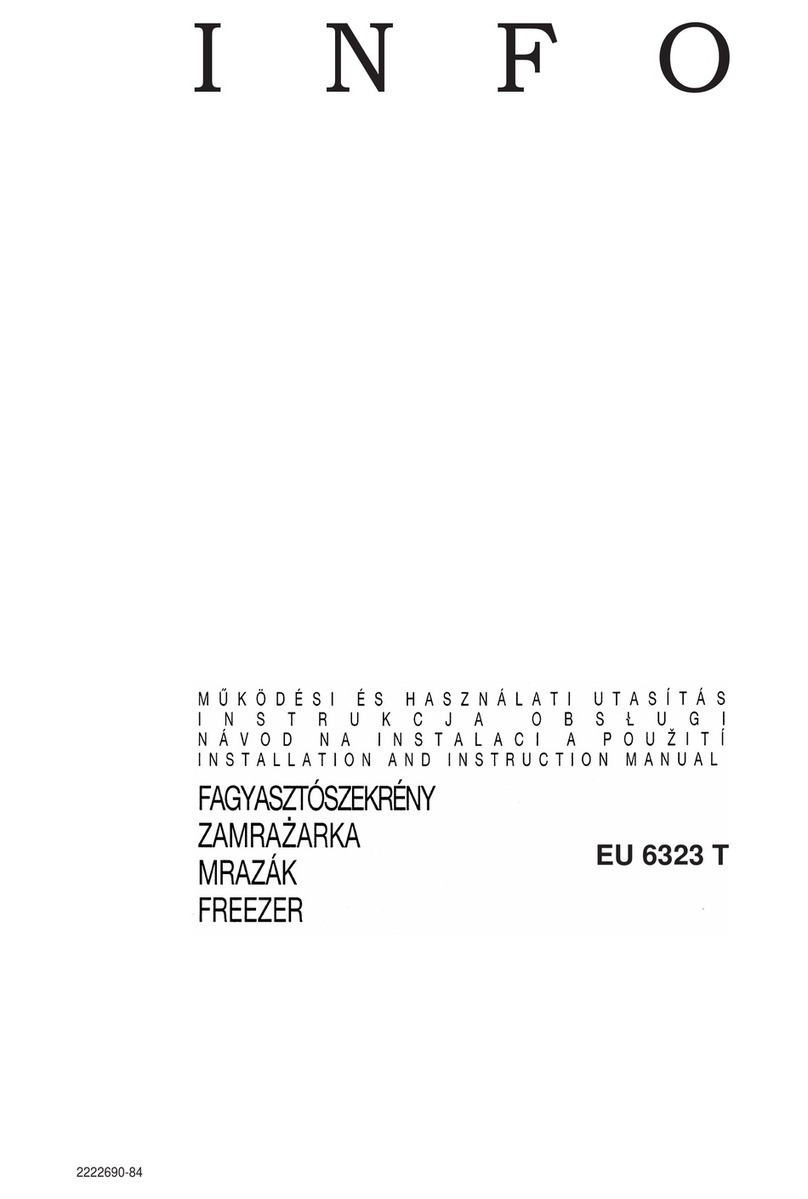
Electrolux
Electrolux EU 6323 T Installation and instruction manual


